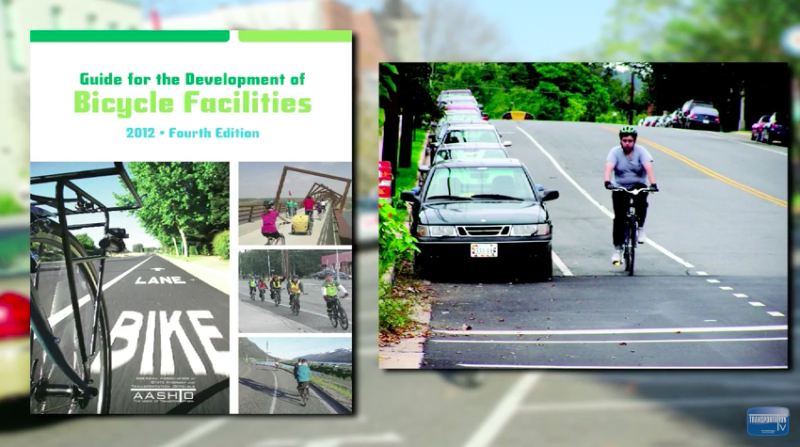Try to picture American cities if they had started building world-class bike infrastructure en masse in the 1970s, instead of 40 years later. How much safer would our streets be today? How much more active would we be? How many more years would people have enjoyed instead of getting their lives cut short by traffic crashes or chronic cardiovascular disease?
It's not that far-fetched a scenario. Davis, California, began to build protected bike lanes in the early 70s, drawing significant interest from other cities. But instead of embracing these street design concepts, American transportation engineers shunned them for a generation.
A new paper from Bill Schultheiss, Rebecca Sanders, and Jennifer Toole of the Toole Design Group looks at what led the engineering establishment down this path and "delayed the development of urban bicycle transportation networks in North America for decades" [PDF].
In the 1970s, the Davis bike network did inspire other cities, especially in California. It also highlighted the need for engineering design guidance, so the innovations in Davis could be refined and then replicated in other places.
In 1972, the engineering firm DeLeuw Cather surveyed people in Davis and found they preferred to both bike and drive on streets with bike lanes than those without. Few crashes occurred in the bike lanes, but the study noted some difficulties that will sound familiar today: potential conflicts caused by passengers opening car doors, or between cyclists and pedestrians on sidewalk-grade bike lanes, for instance.
As more California cities installed bike lanes and paths, a few municipalities passed mandatory side path laws, which required people to ride in a bikeway if one was available. This provoked a reactionary movement among some cyclists, led by the engineer and amateur bike racer John Forester.
Forester and his followers were worried about being confined to sidewalks where they couldn't ride fast. A mandatory side path law that accompanied bike infrastructure installed in Palo Alto inspired Forester to write "Effective Cycling," a book advancing his credo that "bicyclists fare best when they act as, and are treated as, drivers of motor vehicles."
To discredit California's emerging bike infrastructure, Forester conducted personal "experiments" where he attempted left turns off sidewalk-level bike paths at high speeds.
Forester "published his account of this ride as 'the one valid test of a sidepath system' that proves sidepath style bikeways were 'about 1,000 times more dangerous than riding on the same roads,'" Schultheiss writes. Although Forester's experiment was obviously anecdotal and highly subjective, his credentials as an engineer helped lend a scientific veneer to his ideological campaign.
By the mid-1970s, the data on bike infrastructure "were consistent with modern-day research on bicyclists’ preferences and safety," writes Schulteiss. "Bicyclists preferred separation, there were fewer crashes between bicyclists and motorists on streets with bike lanes compared to streets with shared lanes, and facilities that require bicyclists to move in the contra-flow direction resulted in more crashes."
Forester sapped this momentum. He seized on some of the safety issues pointed out by DeLeuw Cather and others as evidence that, as Schultheiss puts it, "all methods of separation were unsafe, failing to acknowledge the studies had found that streets with bike lanes were safer than streets without." By gaining leverage over influential guidance in the street engineering profession, Forester stunted bikeway development of bikeway.
The Association of American State Highway and Transportation Officials produced the first edition of its bikeway guide in 1974. It was surprisingly progressive by the standards of the time, with recommendations about protected and unprotected bike lanes. Although it cautioned against protected bike lanes, the 1974 guide advised cities where different types of bikeways are appropriate, given factors like motor vehicle speed and volumes.
By the late 1970s, Forester was president of the California Association of Bicycling Organizations, which shaped the Caltrans Bicycle Guide in 1978. That document, says Schultheiss, "codified vehicular cycling as the primary method for accommodating bicyclists." When AASHTO wrote its next Bicycle Guide in 1981, the 1978 Caltrans Guide "was used as a starting point," according to Richard Lemieux, an engineer who was the FHWA bicycle program manager at the time.
Dedicated bike infrastructure was out, riding a bike like you drive a motor vehicle was in.
Another version of the AASHTO bikeway guide was not produced until 1991. Interest in bike infrastructure was flagging, and the 1991 guide did not contain many changes.
It took another wave of research funded by the 1991 federal transportation bill for the engineering establishment to question the conventional wisdom that had hardened around Forester's vehicular cycling philosophy. That decade, the FHWA oversaw a number of studies examining the safety of bikeways, and some of the findings indicated that on-street bikeways were indeed safer.
Successive versions of the AASHTO guide showed marginal progress, but it wasn't until cities took the initiative and began implementing protected bike lanes in the 2000s that American bikeway engineering caught up to where Davis had been in the 1970s.
As Steven Higashide recounts in the Atlantic, urban DOTs in New York, DC, Chicago, and other cities filled a vacuum left by AASHTO and popularized protected on-street bike lane designs independently. By banding together as the National Association of City Transportation Officials and producing an Urban Bikeway Design, they have led hundreds of other cities to implement the type of bike infrastructure that John Forester disdained.
Since 2010, the overwhelming preponderance of research has shown not only the people prefer to ride in dedicated bike infrastructure, but that these street designs improve safety for everyone.





